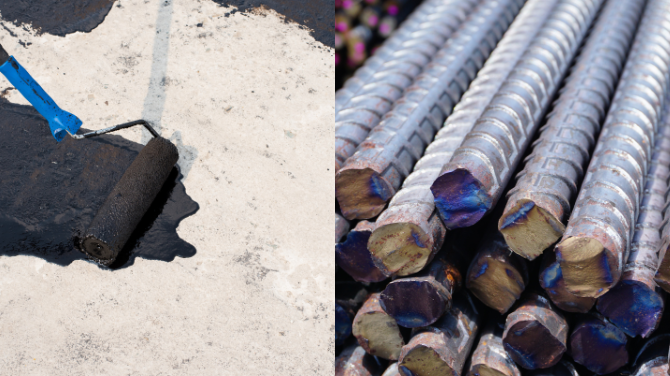The waterproofing and protection of steel and concrete bridges are crucial during their construction because bridges are subjected to high mechanical stresses throughout their lifespan and in such large, important building structures, there are numerous factors that significantly damage the concrete substrates, causing the corrosion of the reinforcement. In particular, adverse climatic conditions have a negative impact on the longevity of bridges and have a substantial impact on their durability over time. The installation of a waterproofing system with crack bridging capabilities is required because steel and concrete bridges are subject to heavy loads that cause constant movement.
This increases protection and allows for their movement, which may result in the development of new cracks. The chemical aggressiveness of various substances, such as salts and oils, which fall to the asphalt and then permeate the bridge deck, which may result in the degradation of the concrete, is another crucial issue that arises. These elements make waterproofing the bridge deck with high chemical resistance technologies essential for preventing concrete degradation.
For a number of reasons, steel and concrete bridges need to be waterproofed. The main goal is to prevent moisture from entering the surface. The structural contents must also be protected from water intrusion, which can weaken the concrete or cause the steel reinforcement to corrode. Concrete is porous by nature, allowing water to pass through by capillary action, water vapour gradient, or hydrostatic pressure. Cracks, structural flaws, and badly planned or fitted joints can all allow water to enter. Waterproofing is also necessary to prevent concrete degradation brought on by internal and outside pollutants present at the construction site.
Redwop Chemicals is the best Waterproofing Chemicals manufacturer in India
The fact that water can flow through is the concern with this situation. In the end, both the steel reinforcements and the chemical composition of the concrete are harmed. Contractors rely on waterproofing to prevent water damage to surfaces and structures made of concrete. Concrete and steel will eventually deteriorate due to water. They won’t just look worn out, the structural integrity will also erode. And you can bet the interior of a concrete and steel structure is destroyed if the outer surface is damaged. Therefore, waterproofing is necessary if you want to keep them strong and durable. Here are some benefits of waterproofing steel and concrete bridges
Benefits Of Using Waterproofing For Steel And Concrete Bridges
Increases Durability – Waterproofing of steel makes it more durable, with the use of plate girders, tied arches, suspension bridges, cable-stayed bridges, and trusses, steel is capable of spanning spans that are much longer than 150 meters. Even in abrasive settings, concrete bridges have shown to be resilient. Bridges made of concrete require less upkeep. Bridges made of concrete may be built quickly by utilizing local labor. Concrete bridges show to be cost-effective both initially and over time. Waterproofing protects it from several factors making it more durable.
Low Maintenance
When required, steel bridges can be effectively repaired, kept in use, and avoided needing to be completely replaced. Waterproofing makes it much easier to maintain without permanently taking the bridge out of operation, certain components can be reinforced with more steel or replaced. With well-documented heat-straightening processes, impacts and damage from overheight cars below the bridge are frequently quickly and simply repaired. When a steel bridge needs maintenance, repairs, or rehabilitation, it is frequently possible to do so while still allowing all or some traffic to utilize the bridge in operation. Concrete Bridges once made properly, do not require any kind of special maintenance and supervision. Concrete’s long-term cost-effectiveness is highly appealing because of its low initial construction costs and little need for inspection and maintenance. It is one of the most durable materials used for construction and waterproofing makes it more strong and steady hence making it a low-maintenance material to use.
Sustainability
Over the past 100 years, 100-year steel bridges have been constructed. Steel was used in the construction of several renowned, illustrious, and beloved bridges, including the Brooklyn Bridge, and Eads Bridge to mention a few. These 100-year bridges have demonstrated their resistance to terrible weather and extraordinary events with the proper upkeep. Steel materials, waterproofing, coatings, and construction methods used to construct modern steel bridges have the potential to make them even more durable than those used to construct steel bridges a century ago. A sustainable alternative for building bridges is provided by concrete, a locally produced material with minimal negative effects on the environment and society. Concrete also lends itself to constructions with a normal design life of at least 100 years and with waterproofing it goes up to 20-25 years more and requires little maintenance. Additionally, up to 95% of the concrete and reinforcing used in bridges is recyclable when its useful life is through.
Time-Saving Constructions
Structural steel is fabricated off-site using geometrically controlled machinery, which has the benefit of being ready to construct as soon as it gets to the bridge site. Installation of formwork and reinforcement is not necessary. Waterproofing makes it more relevant as it has no replacements once installed due to its increased durability. The erection of structural steel is not restricted to a particular temperature range. For the same span, structural steel is frequently lighter than other materials, requiring smaller or fewer erection cranes. The use of structural steel in a bridge project speeds up construction, lowers the number of on-site workers needed, and lowers project costs in general. Concrete may be the quickest and least expensive building material for long-lasting, high-quality bridges with adequate waterproofing, preplanning, precasting of parts, and the use of appropriate technologies in design and construction. Concrete bridge systems may be quickly and affordably constructed using methods like sliding, launching, jacking, or modular construction.
Conclusion
Waterproofing of steel and concrete bridges has shown a great number of results and is one of the best and most reliable ways to make them durable, time-saving, sustainable, and maintain construction costs. It is one of the most trusted methods used globally by the construction industry. Steel and concrete are the greatest building material for any bridge project, regardless of size, form, or intended purpose, due to their strength, beauty, affordability, ease of production, and quick deployment methods. Waterproofing has a huge contribution to making them one of the most used construction materials worldwide.
Redwop is a prime waterproofing manufacturer in India that is involved in the production of a wide array of waterproofing solutions used in numerous residential and commercial construction applications. These solutions are manufactured using state-of-the-art technology and comply with international standards of construction.



